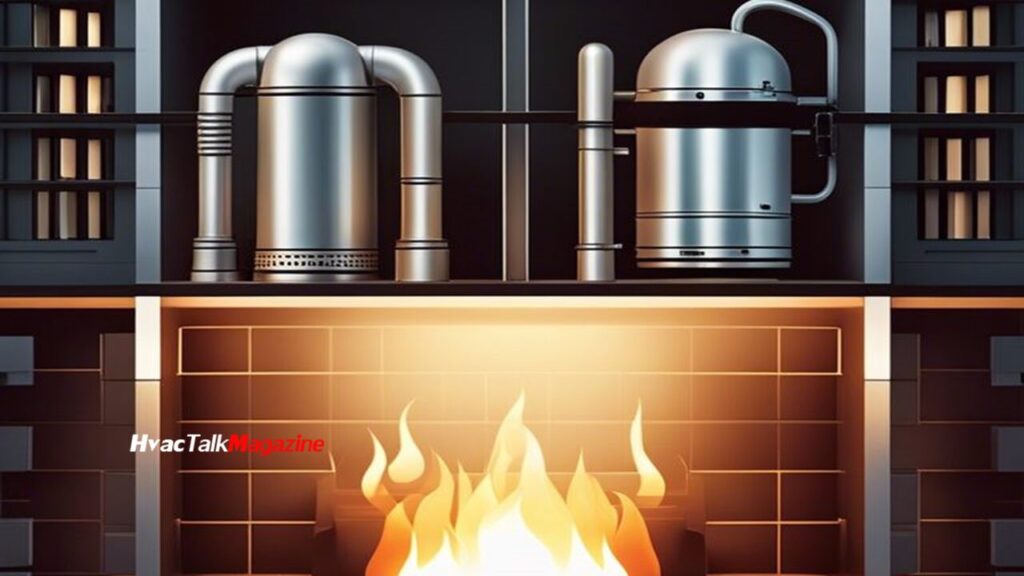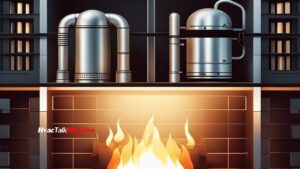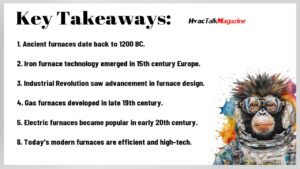What is the history of the modern furnace?
As you sit comfortably in your warm home, have you ever wondered how humans managed to survive harsh winters before the advent of modern heating systems? The answer lies in the fascinating history of the furnace, a device that has undergone significant transformations over the centuries. From ancient civilizations to modern innovations, the evolution of the furnace has been marked by moments of genius, tragedy, and perseverance. In this journey through time, you’ll discover how the modern furnace came to be, and how it has revolutionized the way we live and work.
What is the history of the modern furnace? Key Takeaways:
The history of the modern furnace is a long and fascinating one, spanning centuries and involving the contributions of many inventors and innovators. Here are 7 key takeaways about the history of the modern furnace:
- Ancient Roots: The concept of a furnace dates back to ancient civilizations, with evidence of primitive furnaces used for metalworking and heating found in ancient Egypt, Greece, and Rome.
- Industrial Revolution: The modern furnace as we know it today began to take shape during the Industrial Revolution in the 18th and 19th centuries, with the development of coal-fired furnaces and the introduction of steam power.
- Cast-Iron Innovations: In the mid-19th century, the introduction of cast-iron furnaces revolutionized home heating, providing a more efficient and affordable way to warm homes.
- Oil-Fired Furnaces: The early 20th century saw the rise of oil-fired furnaces, which offered greater efficiency and convenience than their coal-fired predecessors.
- Electric Furnaces: The mid-20th century saw the development of electric furnaces, which provided a safer and more environmentally friendly alternative to oil-fired furnaces.
- High-Efficiency Furnaces: In the latter half of the 20th century, the focus shifted to developing high-efficiency furnaces that could achieve greater energy savings and reduce environmental impact.
- Modern Advancements: Today, modern furnaces continue to evolve with advancements in technology, including the use of smart sensors, Wi-Fi connectivity, and advanced materials that improve efficiency and performance.
What is the history of the modern furnace? : Early Beginnings
Before we probe the history of the modern furnace, let’s take a step back and explore the early beginnings of heating systems.
Ancient Civilizations
Early forms of heating date back to ancient civilizations, where people used primitive methods to warm their homes. In ancient Greece and Rome, hypocausts were used, which involved hot air circulating under the floor to warm the space. This innovative system was a precursor to modern central heating.
Medieval Period Developments
Developments in heating technology continued during the medieval period when castles and monasteries employed open fireplaces and chimneys to provide warmth.
Medieval heating systems were often dangerous and inefficient, with open flames and poor ventilation posing significant risks. However, these early attempts at central heating laid the groundwork for future innovations. During this time, the concept of radiant heat began to take shape, where heat from a central source was distributed through pipes or ducts to warm surrounding areas. This idea would later become a crucial component of modern furnace design.
What is the history of the modern furnace? : Industrial Revolution and the Birth of Modern Furnaces
Even as the early furnaces were being used, the Industrial Revolution was transforming the way goods were produced and manufactured. This period, which spanned from the late 18th to the mid-19th century, saw the development of new technologies and innovations that would change the face of the industry forever.
Innovations in Iron and Steel Production
Any discussion of the Industrial Revolution would be incomplete without mentioning the innovations in iron and steel production. The introduction of the Bessemer process in 1855 allowed for the mass production of steel, which was stronger and more durable than iron. This led to the widespread adoption of steel in construction and manufacturing, paving the way for the development of modern furnaces.
The First Coal-Fired Furnaces
With the advent of coal-fired furnaces, the Industrial Revolution gained momentum. These furnaces, which used coal as a fuel source, were more efficient and produced higher temperatures than their predecessors.
Production of coal-fired furnaces marked a significant turning point in the history of furnaces. For the first time, furnaces could operate continuously, producing large quantities of goods at a lower cost. This led to a surge in industrial production, as manufacturers could now produce goods on a larger scale. However, the use of coal also introduced new safety risks, including the threat of explosions and respiratory problems for workers. Despite these challenges, the benefits of coal-fired furnaces far outweighed the drawbacks, and they quickly became the standard in industry.
What is the history of the modern furnace? Late 19th and Early 20th Centuries
Keep in mind that the late 19th and early 20th centuries were pivotal times for the development of the modern furnace. This period saw significant advancements in furnace technology, which would go on to shape the industry for decades to come.
The Advent of Gas Furnaces
On the heels of the Industrial Revolution, the late 19th century witnessed the introduction of gas furnaces. These furnaces utilized coal gas or natural gas as a fuel source, providing a cleaner and more efficient alternative to traditional wood-burning furnaces. This marked a significant shift away from wood-burning furnaces, which were notorious for producing hazardous emissions and posing fire hazards.
Electric Furnaces Emerge
One of the most notable developments during this period was the emergence of electric furnaces. In the early 20th century, electric furnaces began to gain popularity, offering an even cleaner and more efficient means of heating homes.
For instance, electric furnaces eliminated the need for fuel storage and combustion, making them a much safer option for homeowners. Additionally, electric furnaces were relatively low-maintenance and produced no emissions, making them an attractive choice for those concerned about indoor air quality. However, it’s worth noting that the high cost of electricity at the time made electric furnaces a luxury only the wealthy could afford. Despite this, electric furnaces paved the way for future innovations in furnace technology.
What is the history of the modern furnace? Modern Era and Beyond
Despite the significant advancements made in furnace technology during the mid-20th century, the industry continued to evolve in response to changing environmental concerns and consumer demands.
High-Efficiency Furnaces and Environmental Concerns
On the heels of growing concerns about energy consumption and air pollution, the 1980s saw the introduction of high-efficiency furnaces that boasted AFUE (Annual Fuel Utilization Efficiency) ratings of 90% or higher. These furnaces significantly reduced energy waste and emissions, making them a more environmentally friendly option for homeowners.
Contemporary Furnace Designs and Technologies
Furnace manufacturers have continued to push the boundaries of innovation, incorporating advanced technologies and designs that prioritize efficiency, safety, and comfort.
Technologies such as modulating gas valves, which adjust heat output in real time to match your home’s specific heating needs, have become increasingly popular. Additionally, smart furnace systems that can be controlled remotely and learn your schedule to optimize energy usage have gained traction. Furthermore, the development of two-stage and variable-speed furnaces has enabled more precise temperature control and reduced energy consumption. While carbon monoxide poisoning remains a potential risk, modern furnaces are designed with enhanced safety features, such as automatic shut-off valves and advanced sensors, to minimize this danger. Overall, these advancements have led to safer, more efficient, and environmentally friendly heating solutions for homeowners like you.
What is the history of the modern furnace? Final Words
As a reminder, the history of the modern furnace is a testament to human ingenuity and perseverance. You’ve witnessed the evolution of heating technology, from ancient civilizations to the innovative breakthroughs of the Industrial Revolution. Through your journey, you’ve seen how pioneers like Benjamin Franklin and Willis Carrier contributed to the development of modern furnaces. Now, as you bask in the warmth of your own home, remember the remarkable story behind the humble furnace that keeps you cozy, and appreciate the comfort it brings to your daily life.
Tip of the Day
Transform your home’s comfort with the best heating and cooling systems! Discover top-rated, energy-efficient solutions for year-round climate control.
👉 Shop now and find the perfect heating and cooling system to suit your needs. Enhance your home’s comfort and efficiency today!
FAQ
Q: When was the first modern furnace invented?
A: The first modern furnace was invented in the late 18th century by Count Rumford, an American-born British physicist and inventor. In 1799, Rumford designed a furnace that used a combination of coal and air to produce a high-temperature flame, which was more efficient and cleaner than earlier furnace designs.
Q: What were furnaces like before the modern era?
A: Before the modern era, furnaces were typically small, inefficient, and dirty. They were often little more than holes in the ground or primitive structures made of clay or stone, and they burned wood or other fuels to produce heat. These early furnaces were not very effective at producing consistent heat, and they often produced a lot of smoke and pollution.
Q: How did the Industrial Revolution impact the development of modern furnaces?
A: The Industrial Revolution had a significant impact on the development of modern furnaces. With the advent of new materials and manufacturing techniques, furnaces became larger, more efficient, and more sophisticated. The introduction of iron and steel allowed for the construction of larger, more durable furnaces, and the development of coal mining made it possible to fuel these furnaces with a cheaper and more abundant energy source.
Q: What role did the invention of the thermostat play in the development of modern furnaces?
A: The invention of the thermostat in the late 19th century played a crucial role in the development of modern furnaces. The thermostat allowed for precise control over the temperature of the furnace, making it possible to maintain a consistent heat output and reduce energy waste. This innovation made furnaces more efficient, safer, and more comfortable to use.
Q: How have modern furnaces evolved in terms of safety features?
A: Modern furnaces have evolved significantly in terms of safety features. Today’s furnaces are equipped with a range of safety features, including automatic shut-off valves, flame failure shut-off devices, and carbon monoxide detectors. These features help to prevent accidents, reduce the risk of fires, and protect homeowners from the dangers of carbon monoxide poisoning.
Q: What are some of the most common types of modern furnaces?
A: There are several common types of modern furnaces, including gas furnaces, oil furnaces, electric furnaces, and heat pumps. Gas furnaces are the most popular type, accounting for over 60% of all furnaces in use today. They are known for their efficiency, reliability, and relatively low operating costs.
Q: How have modern furnaces impacted the environment?
A: Modern furnaces have had a significant impact on the environment. While they are generally more efficient and cleaner than earlier furnace designs, they still produce greenhouse gas emissions and contribute to climate change. However, many modern furnaces are designed to be more environmentally friendly, with features such as high-efficiency burners, condensing technology, and programmable thermostats that help to reduce energy waste and minimize environmental impact.
Learn more and join our mailing list for updates.
Follow Us on Google Chrome
To get started, switch to Google Chrome Browser
1. Already on our site
2. Top right, tap the 3 dots
3. Bottom right, tap follow
4. You are done.
This post has been written by Team HVAC Talk Magazine. Stay informed and connected with the latest in HVAC—join us for expert advice, troubleshooting tips, and news updates. Don’t miss out, follow us now! #HVACExperts #HVACTips #StayInformed #HVACProTalk!











